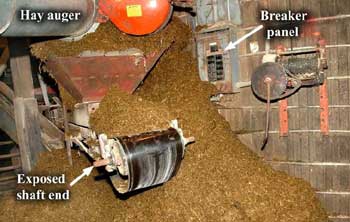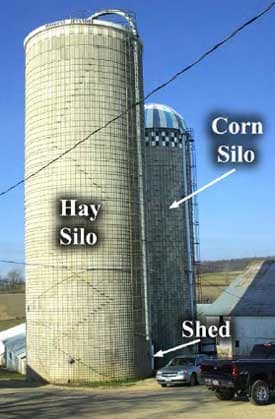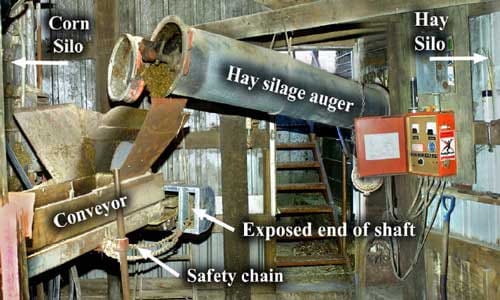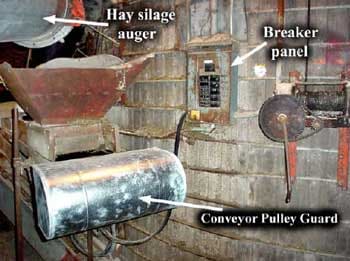45-Year-Old Cattle Farmer Entangled in Exposed Rotating Conveyor Shaft
Iowa Case Report: 04IA059
Report Date: June 8, 2005
Summary
During the fall of 2004, a 45-year-old Iowa farmer was killed when he became entangled in the exposed shaft of a silage conveyor pulley. He was mixing and feeding silage to his herd of heifers. Hay silage from an oxygen-limiting silo was mixed with corn silage from another silo, and the conveyor belt carried the mixture to a feed bunk 60 feet (27 m) long. The mixing took place in a shed between the two silos, which were approximately 10 feet (3 m) apart. Controls for the silo unloaders were mounted on the walls of each silo. The hay silo had a control switch box, while the corn silo was controlled from a breaker panel (Photo 1). This panel also controlled the conveyor belt motor. This configuration of switches required the farmer to walk around the exposed end of the conveyor belt at least three times during each feeding cycle. The shaft for the conveyor belt pulley extended about three inches (75 mm) beyond the bearings on each side. A keyway was cut into the length of the 1-inch (25 mm) diameter shaft, and there was no guard around the conveyor belt or the shaft. The injury occurred when the farmer apparently leaned or bent over too close to the shaft. The hood of his nylon jacket became entangled in the exposed shaft end. The hood and arm of his jacket wound up in the shaft strangling him and stalling the conveyor. Silage kept piling up from the silo, and the conveyor motor and drive kept running, eventually burning through the west end of the stalled conveyor belt. The victim was discovered by his wife. He had suffered fatal injuries before rescuers arrived.
 |
|
Photo 1 – Doorway view of end of conveyor belt after victim was removed.
|
Recommendations based on our investigation are as follows:
- Machinery and equipment must be guarded properly to avoid entanglements.
- Control switches and stationary machinery should be placed so that there is no need to work near hazardous machine parts.
- Farmers should carry a communication device for emergency situations.
- Farmers should wear appropriate, well-maintained clothing for farm work.
Introduction
In the fall of 2004, a 45-year-old Iowa cattle grower was killed while feeding silage to his heifers. The Iowa FACE program was notified of this incident two days later, and began an investigation. Information for this case was gathered from the Medical Examiner, the County Sheriff, and newspapers. A site visit was conducted in the early winter. Two FACE investigators accompanied by a Sheriff’s Investigator and Medical Examiner Investigator met with the victim’s family members at the farm where this incident occurred. Photographs were obtained from the Sheriff’s office, and additional photos were taken of the feeding shed, structures, and equipment.
This farm was a century-old dairy farm. It was operated by the victim and his family. Dairy production had been discontinued 7-8 years ago, and the farm now produced dairy heifers. The farm had 200 acres (80 hectares) of crop land in hay, corn, and soybeans. The victim had lived and worked on this farm his entire life. He also worked off the farm as a truck driver for a local cooperative. The farmer received help from his wife and two grown children. There were no written safety policies in place at this family farm.
Investigation
The farmer was doing routine chores, feeding silage to his cattle in the afternoon. Cattle were normally fed once per day in winter and twice per day during summer months. The normal procedure was to run the conveyor belt and mix hay and corn silage together for 15 minutes, then let the hay auger run for an additional hour. The cattle structures included two cement silos connected by a feeding control shed, which opened into a free-stall barn where the heifers were fed (Photo 2). Down the center of the barn was a conventional two-sided feed bunk 60 feet (27 m) long , with a 12-inch-wide (30 cm) roller bed conveyor belt traveling down its length. Silage was mixed in the shed between the silos and carried to the animals along the conveyor belt. An adjustable moving sled dropped the silage from the belt to alternating sides of the feed bunk. The feed conveyor was purchased and installed new in the late 1970s.
 |
|
Photo 2 – View of both silos, showing position of shed and free-stall barn to the west. |
The oxygen-limiting hay silo was built in the mid 1980s, and was situated on the south of the shed, with control switches mounted to its wall inside the shed. The corn silo was built in 1977 on the north of the shed. It was controlled from a breaker panel box mounted to its side inside the shed. The free-stall barn extended west from the shed. The motor for the conveyor was positioned at the west end in the barn, and the motor was switched on and off using a breaker switch in the electric panel on the north side of the feed shed.
The east end of the conveyor belt was in the middle of the feed shed and had a 6-inch (15 cm) diameter pulley at its end, rotating on a 1-inch (25 mm) diameter shaft which was approximately 20 inches (50 cm) long. This pulley was spring-loaded to maintain constant tension on the conveyor belt. Safety chains were attached to both sides of the pulley in case the belt should break (Photo 3). The shaft and bearings had been replaced several years ago, and the new shaft was long enough to fit the wider 16-inch (41 cm) conveyor model. This longer shaft left three inches (7.5 cm) of exposed shaft on both sides. The shaft had a keyway cut throughout its length, which left sharp corners at the shaft ends. The ends of this shaft were left exposed, and not cut off. The conveyor was not thought to be a great hazard, since the shaft turned at three revolutions per second (180 rpm); slower than tractor power take-off shafts and many other power shafts used in agriculture. During each feeding cycle, the farmer had to walk around the end of this conveyor 3-4 times to access breaker switches on the side of the corn silo.
 |
|
Photo 3 – Composite photograph from the west end of the shed showing both silos, the end of the conveyor belt (now with guard), and the control panel for the hay silo.
|
At about 3:30 PM, the farmer was in the midst of feeding cattle when the left upper portion of his light-weight, nylon hooded jacket became entangled in the exposed end of the conveyor pulley shaft. He was unable to escape as his jacket and cotton shirt wound up tightly around the shaft.
The pulley jammed, yet the motor of the opposite end of the conveyor continued to run, eventually burning through the belt. Hay silage continued to pile up in the area from the silage auger for about an hour, nearly filling the feeding shed before the victim was found. He was discovered by his wife, who called 911 for help.
A neighbor farmer, also a firefighter, heard the call and immediately rushed to the farm, finding the man partially bent over, caught in the shaft. His clothing was cut loose, but he had suffered fatal injuries from the entanglement. The nylon jacket was wrapped 4-5 times around the exposed shaft. On the floor buried under the pile of silage was the farmer’s open pocket knife. It is not known how the knife ended up on the floor, but it is possible that he had dropped it and was caught in the shaft when retrieving it. Another possibility is that he made an attempt to use his knife to cut his entangled clothing free.
Since this farm death, a neighbor, who was a sheet metal worker, constructed a metal box to enclose the end of the conveyor belt (Photo 4). Also, after the investigation, an electrician was scheduled to rewire the switches in the shed, moving all electrical controls to the south wall, adjacent to the existing controls for the hay silo (Photos 3 and 4).
 |
|
Photo 4 – View from doorway showing new metal guard installed over the end of the conveyor belt.
|
Cause of Death
The cause of death according to the Medical Examiner was strangulation.
Recommendations/Discussion
Recommendation #1: Machinery and equipment must be guarded properly to avoid entanglements.
Discussion: Conveyors and feeding equipment have moving and rotating parts. The pulley at the end of this conveyor was not protected and it had entanglement points between the conveyor belt and the pulley as well as at the ends of the rotating shaft. There are well established standards for agricultural machinery guarding which would apply (ANSI/ASAE S493). In this case, the end of the conveyor should be guarded, covering the hazardous moving and rotating parts. After the incident and before our visit a neighboring farmer/sheet metal worker had constructed a guard which appeared to be very functional and effective in protecting this hazardous part of the conveyor (Photo 4).
Recommendation #2 Control switches for stationary machinery should be located so that they don’t create a need to work near hazardous machine parts.
Discussion: As farms adjust to continually changing economic conditions, they frequently remodel and add structures and machinery to the farm operation. This may create situations where the old and new technologies do not match well, creating hazards to the operator. In this case, the old functioning electrical controls were left in their original location, mounted on the side of the first silo. After adding the second silo, the new switches were mounted on the new silo on the other side of the conveyor. It became impossible to reach the controls for the first silo without walking around the conveyor, which is running during feeding. A safer alternative would be to move all controls to one location, eliminating the need to walk around the moving conveyor belt. After our investigation, the family had scheduled an electrician to rearrange the controls in a safer configuration.
Recommendation #3 Farmers should carry a communication device for emergency situations.
Discussion: In many entanglement and injury cases the injured person may be able to call someone for help if he/she has a cell phone or a two-way radio along. It is possible that a communication device would have helped in this injury case. If the injured person is conscious and has the ability to reach and use a communication device immediately, it can make a difference in the outcome. Farmers often work alone and have long periods between meals and other situations where their absence would be noticed. Capability to communicate is particularly important for farmers working long hours alone.
Recommendation #4 – Farmers should wear appropriate, well-maintained clothing for farm work.
Discussion: It is not certain that snagged clothing initiated this entanglement incident. However, it was clothing that contributed to the injury. In general, the selection of appropriate, well-maintained clothing can help prevent injury while working on the farm, especially near parts of moving machinery. Frayed or loose-fitting clothing and dangling draw strings or jewelry can catch on machinery. Clothing should fit close to the body and be tucked inside pants and boots. Clothing with a hood or draw strings should be avoided and all frayed sleeves or cuffs should be trimmed and sewn securely.
References
- ANSI/ASAE S493. Guarding of Agricultural Equipment.
- NASD. Choosing Safe Clothing for Farm Work. Atlanta, GA: Centers for Disease Control. National Agricultural Safety Database at http://www.nasdonline.org/index.htmlexternal icon. Accessed 9 June 2005. (Link updated 8/5/2009)
Iowa FACE Program
Fatality Assessment and Control Evaluation, FACE, is a program of the National Institute for Occupational Safety and Health (NIOSH), which is part of the Centers for Disease Control and Prevention of the U.S. Department of Health and Human Services. Nationally, the FACE program identifies traumatic deaths at work, conducts in-depth studies of select work deaths, makes recommendations for prevention, and publishes reports and alerts. The goal is to prevent occupational fatalities across the nation.
The NIOSH head office in Morgantown, West Virginia, carries out an intramural FACE case surveillance and evaluation program and also funds state-based programs in several cooperating states. In Iowa, The University of Iowa through its Injury Prevention Research Center works in conjunction with the Iowa Department of Public Health and its Office of the State Medical Examiner to conduct the Iowa FACE program.
Nationally, NIOSH combines its internal information with that from cooperating states to provide information in a variety of forms which is disseminated widely among the industries involved. NIOSH publications are available on the web at https://www.cdc.gov/NIOSH/FACE/ and from the NIOSH Distribution Center (1-800- 35NIOSH).
Iowa FACE also publishes its case studies, issues precautionary messages, and prepares articles for trade and professional publication. In addition to postings on the national NIOSH web site, this information is posted on the Iowa FACE site, http://www.public-health.uiowa.edu/FACE/external icon. Copies of FACE case studies and other publications are available by contacting Iowa FACE, too.
The Iowa FACE team consists of the following specialists from the University of Iowa: Craig Zwerling, MD, PhD, MPH, Principal Investigator; John Lundell, MA, Co-Investigator; Murray Madsen, MBA, Chief Trauma Investigator; and Co-Investigator/specialists Risto Rautiainen, PhD, and Wayne Sanderson, PhD, CIH. Additional expertise from the Iowa Department of Public Health includes Rita Gergely, Principal Investigator, and John Kraemer, PA, from the Office of the State Medical Examiner.
To contact Iowa State FACE program personnel regarding State-based FACE reports, please use information listed on the Contact Sheet on the NIOSH FACE web site Please contact In-house FACE program personnel regarding In-house FACE reports and to gain assistance when State-FACE program personnel cannot be reached.

